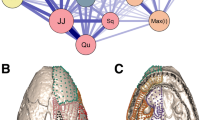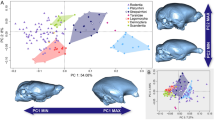Abstract
Birds are the most diversified forms of modern terrestrial vertebrates. They are archosaurs, and are related to Theropoda within Dinosauria. Even though bird morphology has been a subject of interest for centuries, most studies have focused solely on discrete morphological characters, leaving a gap in the understanding of morphological organization and integration in macroevolution. We present this chapter to exemplify a quantitative exploration of the macroevolutionary trends of skull morphological diversity in theropod dinosaurs including modern birds. Using a sample with taxa representative of all of known modern avian Orders, skull disparity is described over a morphospace modeled from shape variables obtained by General Procrustes methods. High taxonomical categories imply large-scale morphological difference, thus landmarks were selected according to evolutionary homologous and developmental conservative areas. Morphological diversity of the skull relies mainly on craniofacial variation, and can be found within the first four dimension of a PCA. Modern avian forms have a strikingly localized, but not morphologically independent, variation at the rostrum. Craniofacial variation unfolds in a range of structurally straight-flexed appearance dependant on the covariation between the rostrum and braincase, structurally mediated by the antorbital cavity. Extinct theropods occupy a region within morphospace resembling an extreme straight skull. Major macroevolutionary changes are likely associated to expansion of the braincase.
Access this chapter
Tax calculation will be finalised at checkout
Purchases are for personal use only
Preview
Unable to display preview. Download preview PDF.
Similar content being viewed by others
References
Bang BG (1971) Functional anatomy of the olfactory system in 23 orders of birds. Acta anatomica 79 (Supplement):l-76
Baumel JJ, Witmer LM (1993) Osteologia. In: Baumel JJ, Evans EH, Van der Berge JC (eds) Handbook of Avian anatomy: Nomina Anatomica Avium, 2nd edition. Publications of the Nuttal Ornithological Group Number 23, Cambridge, pp 45–32
Bock WJ (1965) Kinetics of the avian skull. J Morphology 114 (1): 1–41
Bookstein FL (1991) Morphometric tools for landmark data: Geometry and biology. Cambridge University Press, New York
Bout RG, Zweers GA (2001) The role of cranial kinesis in birds. Comparative Biochemistry and Physiology Part A, 131: 197–205
Bailer P (1981) Functional morphology of the avian jaw apparatus. In: King AS, McLel- land J (eds) Form and Function in Birds, vol 2. Academic Press, London, pp 439–468
Chaterjee S (1999) The rise of birds. 225 Million years of evolution. The John Hopkins University Press, Baltimore, London
Chiappe LM (1995) The phylogenetic position of the Cretaceous birds from Argentina: Anatomy and systematics of the Enantiornithes and Patagopteryx deferraiisi. Cour Forsch Senkenb 181: 55–63
Colbert EH (1989) The Triassic dinosaur Coelophysis. Museum of Northern Arizona Bulletin 57: 1–160
Cracraft J (1986) The origin and early diversification of birds. Paleobiology 12 (4): 383–399
Cracraft J, Clarke J (2001) The basal clades of modern birds. In: Gauthier J, Gall LF (eds) New Perspectives on the Origin and Early Evolution of Birds. Proceedings of the International Symposium in Honor of John H. Ostrom. Special Publication of the Peabody Museum of Natural History, Yale University, New Haven, pp 143–155
Currie PJ (1995) New information on the anatomy and relationships of Dromaeosaurus albertensis (Dinosauria: Theropoda). J Vert Paleo 15 (3): 576–591
Currie PJ (1997) Raptors. In: Padian K, Currie PJ (eds) Encyclopedia of dinosaurs. Academic Press, London, p 626
Currie PJ, Carpenter K (2000) Acrocanthosaurus atokensis from Antlers Formation, Oklahoma, U.S.A. Geodiversitas 22(2):207–246
Debbaut V, Davis JR (2002) Analysing phenotypic variation: When old-fashioned means up-to-date. J Biosci 27 (3): 191–193
Duijm M (1951) On the head posture in birds and its relation to some anatomical features. I-II Proc Koninklijke Nederlandse Akademie van Wetenschappen, ser C, Biological and Medical Sciences 54: 202–271
Dullemeijer P (1972) Methodology in craniofacial biology. Acta Morphol Neerl-Scand 10: 9–23
Feduccia A (1999). The origin and evolution of birds, 2nd edition. Yale University Press, New Haven
Fisher HI (1955) Some aspects of the kinetics in the jaw of birds. Wilson Bulletin 67 (3): 175–188
Gaup E (1906) Die entwicklung des kopfskelttes in hertwig. In: Hertwig O (ed) Handbuch der Vergleicherden und Experimentellen Entwickelungstehre vol III, pp 573–855
Gauthier J (1986) Saurischian monophyly and the origin of birds. In: Padian K (ed) The Origin of birds and the evolution of flight. Mem Calif Acad Sci 8, San Francisco, pp 155
Grant BR, Grant PR (1993) Evolution of Darwin Finches caused by a rare climatic event. Proc R Soc London Ser B, 251: 111–117
Hofer H (1952) Der gestalwandel des schädels der säugetiere und vögel, mit besonderer berücksichtigung der Knickungstupen und der shädelbasis. Verhandlungen der Anatomischen Gesellschaft (Jena) 50: 102–113
Jerison HJ (1973) Evolution of the brain and intelligence. Academic Press, New York London
Keller EF (2002) Making sense of Life. Explaining biological development with models, metaphors and machines. Harvard University Press, Cambridge
King AS, King DZ (1979) Avian morphology: General principles. In: King AS, McLelland J (eds) Form and Function in Birds, vol 1.Academic Press, London, pp 1–38
Madsen JH Jr (1976) Allosaurus fragilis. A revised osteology. Utah Geological and Mineral Survey Bulletin 109:1–163
Marinelli W (1928) Über den schadel der Schnepfe. Paleobiologica 1: 135–160
Martin GR (1985) Eye. In: King AS, Mclelland J (eds) Form and function in birds. Academic Press, London, pp 311–374
Marugân-Lobón J, Buscalioni AD (2003) Disparity and geometry of the Skull in Ar- chosauria ( Reptilia: Diapsida). Biological Journal of the Linnean Society 80: 67–88
McGhee GR (1999) Theoretical morphology. The concept and its applications. Perspec- tives in Paleobiology and Earth History. Columbia University Press, New York
Morony JJ, Bock WJ, Farrand J (1975) Reference list of the birds of the world. Publications of the Department of Ornithology, American Museum of Natural History, New York
Norell MA, Clark JM, Makovicki PJ (2001) Phylogenetic relationships among Coelurosaurian theropods. In: Gauthier J, Gall LF (eds) New Perspectives on the Origin and Early Evolution of Birds. Proceedings of the International Symposium in Honor of John H. Ostrom. Special Publication of the Peabody Museum of Natural History, Yale University, New Haven, pp 49–67
Ostrom JH (1973) The ancestry of birds. Nature 242: 136
Padian K (2001) The false issues of bird origins: An historiographic perspective. In: Gauthier J, Gall LF (eds) New Perspectives on the Origin and Early Evolution of Birds. Proceedings of the International Symposium in Honor of John H. Ostrom. Special Geometric morphometrics in macroevolution 173 cial Publication of the Peabody Museum of Natural History, Yale University, New Haven, pp 485–499
Padian K (2003) Evolutionary transitions in the origin of birds. J Vert Paleo 23 (Supplement to Number 3): 84
Padian K, Chiappe LM (1998) The early evolution of birds. Biol Rev 73: 1–42
Proctor NS, Lynch PJ (1993) Manual of ornithology. Avian structure and function. Yale University Press, New Haven
Raff RA (1996) The shape of life; genes, development, and the evolution of animal form. Chicago University Press, Chicago
Richtsmeier JT, Burke Deleon V, Lele SR (2002) The promise of Geometric Morphometrics. Yearbook Phys Anthrop 45: 63–91
Rohlf FJ (2003) TPSseries software for morphometric data; TPSrelw v.1.33; TPSdig. v.1. 34. Department of Ecology and Evolution, SUNY at Stony Brook, NY.
Rohlf FJ, Marcus LF (1993) A revolution in morphometrics. Trends in Ecology and Evolution 8: 129–132
Rohlf FJ, Slice DE (1990) Extensions of the Procrustes method for the optimal superimposition of landmarks. Syst Zool 39: 40–59
Sereno PC, Novas FE (1993) The skull and neck of the basal Theropod Herrerasaurus ischigualastensis. J Vert Paleo 8 (4): 451–476
Siegel AF, Benson RH (1982) A robust comparison of biological shapes. Biometrics 38 (2): 341–350
Slice DE (1994) GRFnd software for morphometric data. Department of Ecology and Evolution, SUNY at Stony Brook, NY
Slice DE (2000) Morpheus et al. software for morphometric data. Department of Ecology and Evolution, SUNY at Stony Brook, NY
Starck D (1955) Die endocraniale morphologie der Ratiten, besonders der Apterygidae and Dinornithidae. Gegenbaurs Morphologisches Jarhbuch 96: 14–72
Witmer LM (1997) The evolution of the antorbital cavity of archosaurs: a study in soft tissue reconstruction in the fossil record with an analysis on the function of pneumacity. Mems Soc Vert Paleo, J Vert Paleo 17 (Suplement):l-73
Zusi R (1993) Patterns of diversity in the avian skull. In: Hanken J, Hall B (eds) The Skull. Patterns of structural and systematic diversity, vol 2. The University of Chicago Press, Chicago, pp 391–437
Author information
Authors and Affiliations
Editor information
Editors and Affiliations
Rights and permissions
Copyright information
© 2004 Springer-Verlag Berlin Heidelberg
About this chapter
Cite this chapter
Marugán-Lobón, J., Buscalioni, Á.D. (2004). Geometric morphometrics in macroevolution: morphological diversity of the skull in modern avian forms in contrast to some theropod dinosaurs. In: Elewa, A.M.T. (eds) Morphometrics. Springer, Berlin, Heidelberg. https://doi.org/10.1007/978-3-662-08865-4_12
Download citation
DOI: https://doi.org/10.1007/978-3-662-08865-4_12
Publisher Name: Springer, Berlin, Heidelberg
Print ISBN: 978-3-642-05980-3
Online ISBN: 978-3-662-08865-4
eBook Packages: Springer Book Archive




